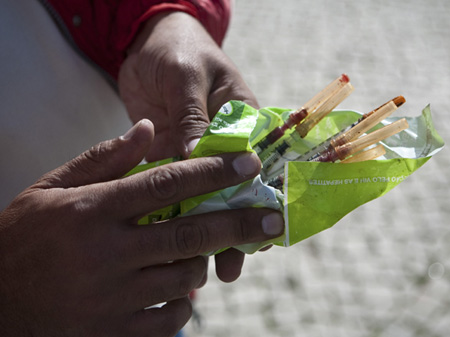New York 2014 is a drug supermarket: never before in history has so much substance been on the street, never has it been so cheap and never so deadly: Between 2010 and 2012, the number of overdose victims shot up by 84 percent:
Mexico as a drug supplier
In recent years, the supply of heroin in New York has increased by 400 percent, smuggled mainly from Mexico, says drug investigator James Hunt. No city in the US, he says, is better suited to the criminal addiction business.
It has become a hub because the largest market has also attracted the largest dealers. It is the second time in its history that New York has been hit by a Herion epidemic: As early as the mid-1960s, the metropolis was considered a drug juggernaut in the USA, but the world only became aware of it when suddenly next to thousands of nameless victims Idols of the then awakening rock generation perished on the needle:
“Heroin became very popular in the entertainment business and artistic circles – and there were deaths: Janis Joplin, Jimmy Hendrix, Jim Morrison – all because of heroin.”
At that time, the Chelsea Hotel on 23rd Street in Manhattan gained a sad reputation – many of the famous dead had temporarily moved into quarters here, in 1978 Sex Pistols bassist Sid Vicious was supposed to stab his girlfriend Nancy Spungen here while he was on drugs, and he died four months later an overdose. The New York crime statistics at the time said there were 40,000 Herion addicts in the city, with up to 9,000 being added every year. Figures that also alarmed politicians: US President Richard Nixon declared drug abuse to be public enemy number one and called for all-out war.
In fact, in the following years there was an easing of tension on the drug front: While heroin was still the most important substance for 95 percent of addicts in 1972, this figure fell to 46 percent by 1978. A success, but not a victory over public enemy number one: New drugs and substances came onto the market: called phencyclidine, PCP or “angel dust” – and cocaine:
“It became a fashion drug, it didn’t have the same stigma as heroin because you could sniff it and not have to inject it, so it was considered cleaner.“
Coke was cheaper than heroin in the 1990s
And coke was comparatively cheap: in the 1990s the kilo had a market value of between 30,000 and 50,000 dollars, the same amount of heroin cost up to 150,000 dollars. The drug came to dealers in Colombia the same way that heroin had before it, but the cartels soon realized that there was room for both drugs in the New York market. So they gave away heroin, concentrated enough to be sniffed like cocaine, and as soon as the addiction found enough new victims, they flooded the city with a mass supply. With the arrival of the Colombians, the era of cheap coins began in New York: A dose of a tenth of a gram now costs between 5 and 12 dollars. But the current new wave of the heroin epidemic is not only due to the low price: Many heroin addicts today suffer from an addiction that the doctor has prescribed for them:
“The reason for the renewed increase in heroin use is an epidemic of people who are addicted to opiates.”
Painkillers are recklessly prescribed
Dr. Andrew Kolodny is the medical director of Phoenix House, a New York rehab clinic specializing in heroin addicts. He complains that colleagues prescribe heavy painkillers too carelessly: Even for mild complaints such as back pain or headaches, preparations such as oxycodone or hydrocodone are prescribed – drugs with a chemical structure similar to that of heroin. Although it has been known since the 1920s that these painkillers lead to addiction and thus abuse, many practices – says Dr. Kolodny – the recipe block is still used far too quickly:
“In other words, the most important step is to encourage general practitioners and dentists to be more careful about prescribing.”
But it is not just carelessness alone: Doctors supply the criminal drug market with pills or prescriptions, prescriptions are falsified, pharmacies are robbed. The consequences are fatal:
“Nobody started heroin: it was painkillers, pills – they get you on your way.“
Made consciously into drug addicts
Danielle went this way. Today she is clean, but they too put painkillers on the needle: Heroin was easier to obtain and much cheaper than the prescription pills. Conversely, this means that many addicts would never have resorted to heroin if they had not first made their own doctors – usually unconsciously – drug addicts:
“The most important thing that we have to do first and foremost is not to let it come to pill addiction in the first place.“
Lifelong therapy for drug addicts
It is a difficult task: Doctors enjoy a high reputation in society, patients trust them or suppress the signs of their dependence with the excuse: Everything is fine, I got these pills from my doctor. And even if pill consumption has become an addiction, many believe they have it under control and can stop at any time. An often fatal illusion, says drug investigator James Hunt:
“People persuade themselves that they control the drug, but unconsciously they have long since surrendered to the drug: No matter how determined or strong one may be – in the end the opiates win.“
Once addicted, you can never get rid of the addiction – if you stop injecting heroin, like diabetics, you need lifelong therapy, but there is still no cure. Around 670,000 US citizens are heroin users and 350,000 are currently receiving treatment for their heroin addiction, but the drug investigation figures give them a grim prognosis: the relapse rate is high, and with it the risk of drug death from an overdose.
–


